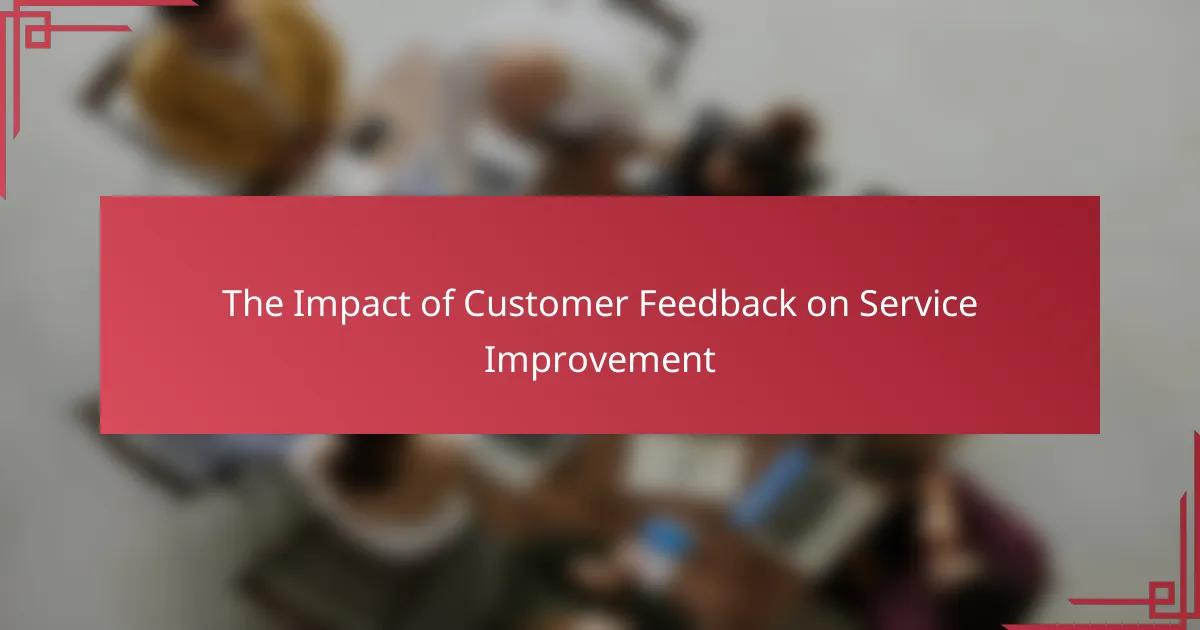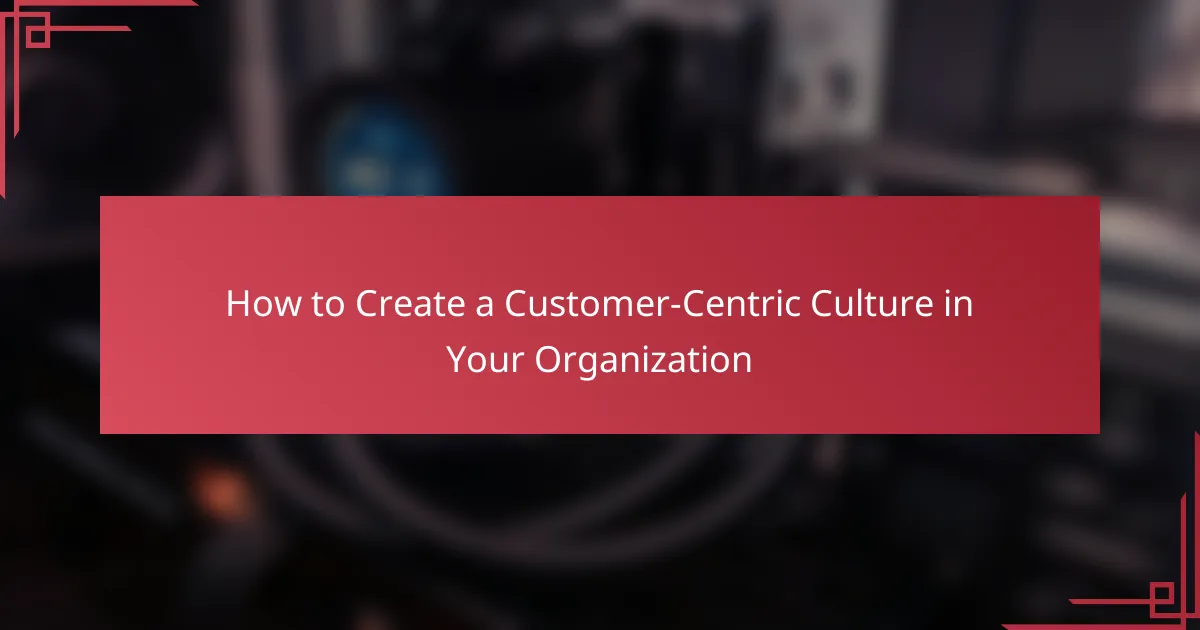Customer feedback is essential for service improvement, offering valuable insights into customer preferences and identifying areas for enhancement. By actively collecting and analyzing this feedback, businesses can adapt their services to align with customer expectations, ultimately boosting satisfaction and loyalty.

How does customer feedback improve services in the UK?
Customer feedback plays a crucial role in enhancing services in the UK by providing insights into customer preferences and areas needing improvement. By actively seeking and analyzing feedback, businesses can tailor their offerings to better meet customer expectations and enhance overall satisfaction.
Identifying service gaps
Customer feedback helps businesses pinpoint specific service gaps that may not be apparent through internal assessments. For instance, if multiple customers report long wait times, this signals a need for process optimization. Regularly collecting feedback through surveys or direct communication can reveal these gaps effectively.
To identify service gaps, companies should focus on both quantitative and qualitative feedback. Analyzing trends in customer ratings alongside open-ended comments can provide a comprehensive view of where improvements are necessary.
Enhancing customer satisfaction
Utilizing customer feedback directly contributes to improved customer satisfaction by addressing concerns and preferences. When businesses act on feedback, customers feel valued and heard, which fosters loyalty. For example, a restaurant that adjusts its menu based on customer suggestions is likely to see an increase in repeat visits.
To enhance satisfaction, companies should implement a systematic approach to feedback collection and response. This includes acknowledging feedback promptly and communicating any changes made as a result, which reinforces positive customer relationships.
Driving innovation
Customer feedback can be a powerful driver of innovation, as it often highlights unmet needs or desires that can inspire new products or services. For example, a tech company might develop a new feature based on user suggestions, leading to a competitive advantage in the market.
To leverage feedback for innovation, businesses should encourage creative input from customers and consider establishing focus groups or beta testing programs. This collaborative approach not only fosters innovation but also strengthens customer engagement and loyalty.
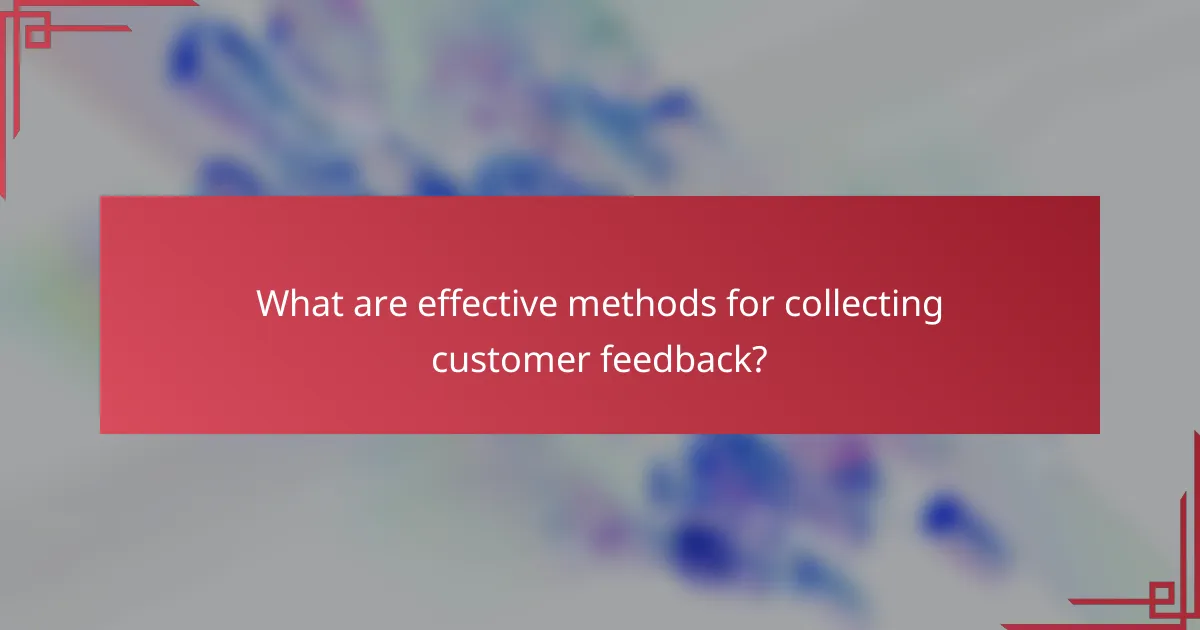
What are effective methods for collecting customer feedback?
Effective methods for collecting customer feedback include online surveys, focus groups, and social media monitoring. Each method has its strengths and can provide valuable insights into customer preferences and experiences.
Online surveys
Online surveys are a popular method for gathering customer feedback due to their convenience and scalability. They can be distributed via email or embedded on websites, allowing businesses to reach a broad audience quickly.
When designing online surveys, keep questions clear and concise. Aim for a mix of multiple-choice and open-ended questions to capture both quantitative and qualitative data. Tools like SurveyMonkey or Google Forms can facilitate the process.
Focus groups
Focus groups involve small groups of customers discussing their experiences and opinions about a product or service. This method provides deeper insights through interactive dialogue and can reveal underlying motivations and feelings.
To conduct effective focus groups, select a diverse group of participants and prepare a set of guiding questions. A skilled moderator is essential to encourage participation and keep the discussion on track. Sessions typically last one to two hours.
Social media monitoring
Social media monitoring involves tracking customer conversations and feedback on platforms like Facebook, Twitter, and Instagram. This method allows businesses to gauge public sentiment and identify trends in real-time.
Utilize tools like Hootsuite or Brandwatch to streamline the monitoring process. Pay attention to both direct comments and mentions of your brand. Engaging with customers online can enhance relationships and demonstrate that their feedback is valued.
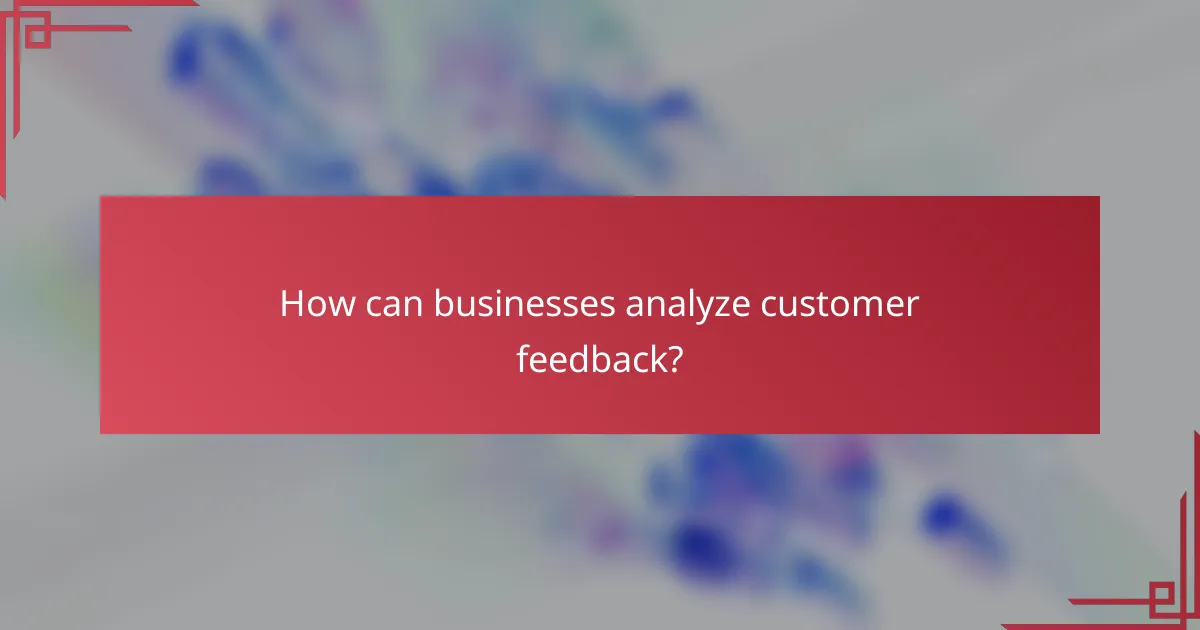
How can businesses analyze customer feedback?
Businesses can analyze customer feedback by employing various tools and techniques that help interpret customer sentiments and improve services. This analysis often involves categorizing feedback, identifying trends, and utilizing software that streamlines the process.
Sentiment analysis tools
Sentiment analysis tools help businesses gauge customer emotions expressed in feedback. These tools use natural language processing to classify comments as positive, negative, or neutral, allowing companies to quickly assess overall customer satisfaction.
Popular sentiment analysis tools include Lexalytics, MonkeyLearn, and Google Cloud Natural Language. When selecting a tool, consider factors like language support, integration capabilities, and pricing, which can vary from free tiers to monthly subscriptions in the low hundreds of USD.
Customer feedback software
Customer feedback software enables businesses to collect, manage, and analyze feedback efficiently. These platforms often include features like surveys, polls, and review management, making it easier to gather insights from various channels.
Examples of effective customer feedback software include SurveyMonkey, Qualtrics, and Typeform. When choosing software, look for user-friendly interfaces, customizable templates, and robust reporting features to ensure that the feedback analysis process is streamlined and actionable.
Data visualization techniques
Data visualization techniques transform complex feedback data into easily understandable formats, such as charts and graphs. These visual representations help stakeholders quickly identify trends, patterns, and areas needing improvement.
Common techniques include bar charts, pie charts, and heat maps. Tools like Tableau and Microsoft Power BI can be particularly useful for creating dynamic visualizations. Ensure that the visualizations focus on key metrics and are tailored to the audience for maximum impact.

What role does customer feedback play in service design?
Customer feedback is crucial in service design as it provides insights into user needs and preferences, allowing businesses to tailor their offerings effectively. By integrating feedback into the design process, companies can enhance user satisfaction and drive continuous improvement.
User-centered design
User-centered design (UCD) prioritizes the needs and experiences of end-users throughout the service development process. This approach involves gathering feedback directly from users to understand their pain points and expectations, ensuring that the final service aligns with their requirements.
To implement UCD effectively, businesses should engage users through surveys, interviews, and usability testing. This can help identify common issues and preferences, leading to more intuitive and user-friendly services. Regularly revisiting user feedback is essential to adapt to changing needs.
Prototyping based on feedback
Prototyping is a vital step in service design that allows businesses to create preliminary versions of their services based on customer feedback. This iterative process helps identify flaws and areas for improvement before full-scale implementation, saving time and resources.
When developing prototypes, companies should incorporate user insights to create realistic scenarios that reflect actual use cases. Testing these prototypes with users can reveal critical information about usability and functionality, enabling teams to make informed adjustments. Aim for multiple iterations to refine the service based on ongoing feedback.
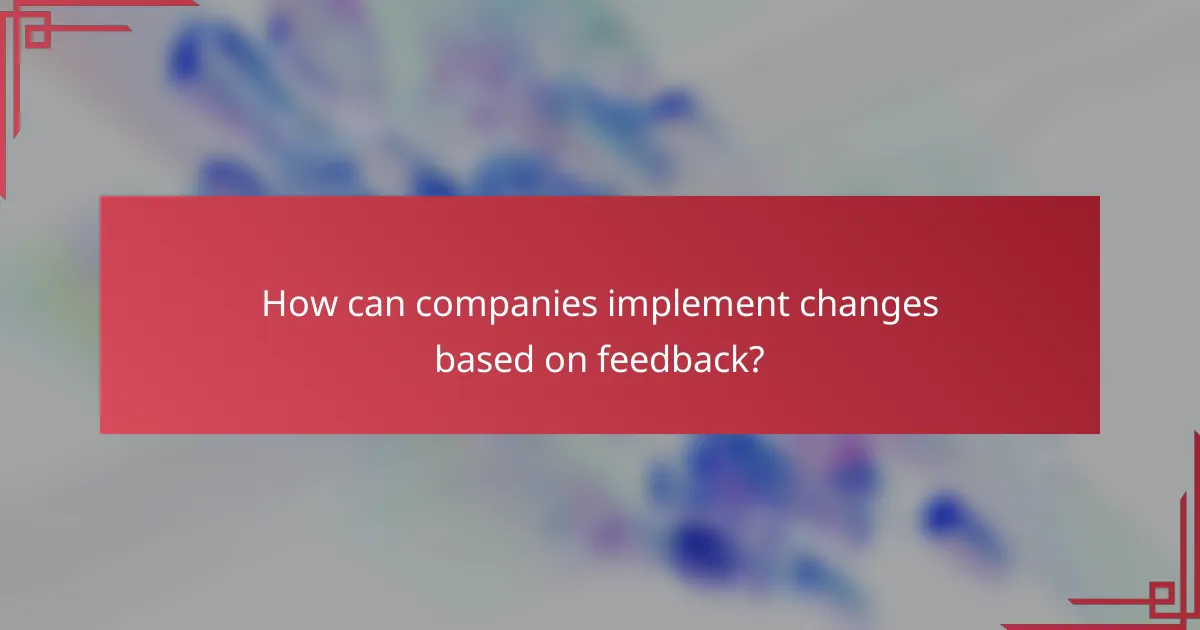
How can companies implement changes based on feedback?
Companies can implement changes based on customer feedback by systematically analyzing the input and prioritizing actionable insights. This process often involves engaging teams across departments to ensure that the feedback translates into tangible improvements in service delivery.
Agile service development
Agile service development focuses on iterative progress and flexibility, allowing companies to quickly adapt to customer feedback. By using short development cycles, teams can implement changes rapidly and assess their impact in real-time.
To effectively utilize agile methodologies, companies should establish cross-functional teams that include members from customer service, product development, and marketing. This collaboration fosters a culture of responsiveness and ensures that feedback is integrated into every stage of service improvement.
Continuous improvement processes
Continuous improvement processes, such as the Plan-Do-Check-Act (PDCA) cycle, help organizations refine their services consistently based on customer feedback. This structured approach allows companies to test changes, evaluate results, and make necessary adjustments over time.
Implementing continuous improvement requires regular training for staff on best practices and feedback analysis. Companies should also establish metrics to measure the effectiveness of changes, ensuring that adjustments lead to enhanced customer satisfaction and loyalty.
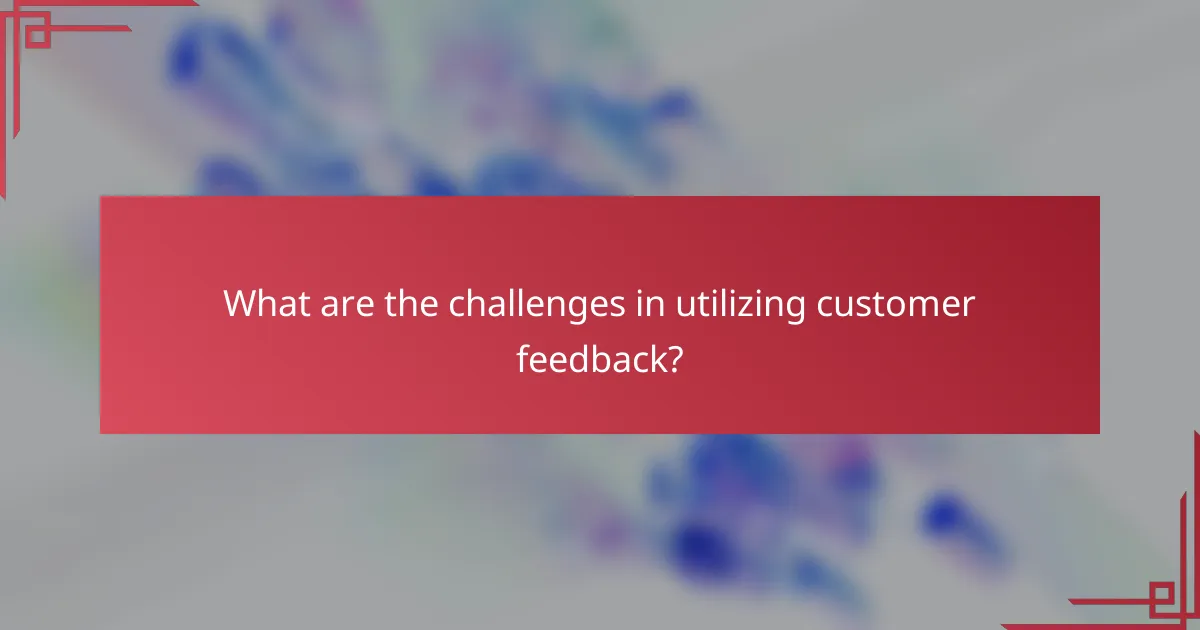
What are the challenges in utilizing customer feedback?
Utilizing customer feedback presents several challenges that can hinder effective service improvement. Key issues include data overload and bias in feedback collection, both of which can complicate the analysis and implementation of improvements.
Data overload
Data overload occurs when organizations receive an overwhelming amount of feedback, making it difficult to extract actionable insights. This can happen when feedback channels are not properly managed or when customers provide excessive detail that obscures key trends.
To mitigate data overload, prioritize feedback sources based on relevance and volume. For example, focus on feedback from frequent customers or specific service interactions rather than all collected data. Implementing categorization techniques can also help streamline the analysis process.
Bias in feedback collection
Bias in feedback collection can skew results and lead to misinterpretations of customer sentiment. This bias may arise from the way questions are framed, the timing of feedback requests, or the demographic characteristics of respondents.
To reduce bias, ensure that feedback requests are neutral and inclusive. Use a mix of qualitative and quantitative methods to gather a well-rounded perspective. Regularly review and adjust your feedback collection strategies to reflect a diverse customer base and avoid systematic errors.
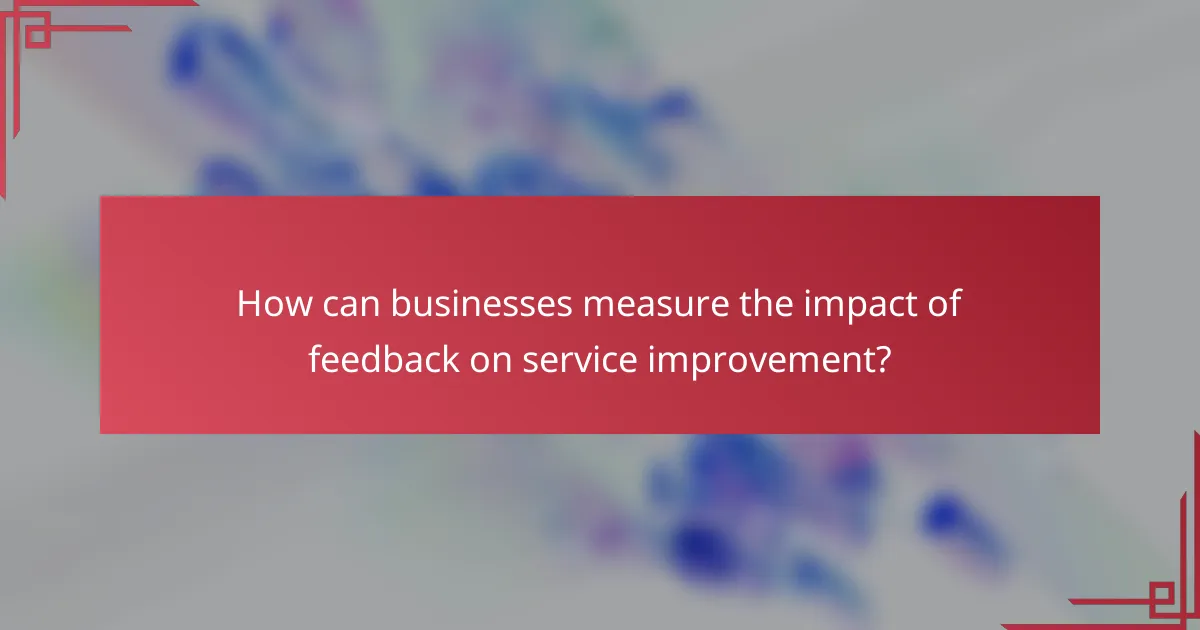
How can businesses measure the impact of feedback on service improvement?
Businesses can measure the impact of customer feedback on service improvement by analyzing key performance indicators (KPIs) that reflect changes in service quality and customer satisfaction. This involves collecting data before and after implementing changes based on feedback to assess effectiveness.
Key performance indicators
Key performance indicators (KPIs) are essential metrics that help businesses evaluate the effectiveness of their service improvements. Common KPIs include customer satisfaction scores, net promoter scores (NPS), and customer retention rates. Monitoring these indicators allows businesses to quantify the impact of feedback on their services.
For instance, if a business receives feedback indicating long wait times, it can implement changes to reduce these times and then track the average wait time as a KPI. A reduction in wait times, coupled with an increase in customer satisfaction scores, would indicate a successful service improvement.
When selecting KPIs, businesses should ensure they align with their specific goals. It’s beneficial to set benchmarks and regularly review these indicators to identify trends and areas for further improvement. Avoid focusing solely on one metric; a combination of KPIs provides a more comprehensive view of service performance.
